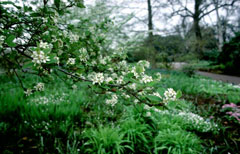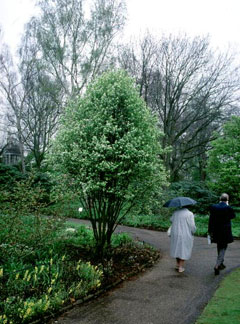 |
|
(c) 2010 Ken Fern & Plants For A Future |
 |
| (c) 2010 Ken Fern & Plants For A Future |
Translate this page:
Summary
Physical Characteristics

 Amelanchier bartramiana is a deciduous Shrub growing to 3 m (9ft 10in).
Amelanchier bartramiana is a deciduous Shrub growing to 3 m (9ft 10in).
See above for USDA hardiness. It is hardy to UK zone 5 and is not frost tender. It is in flower from April to May. The species is hermaphrodite (has both male and female organs) and is pollinated by Bees. The plant is self-fertile.
Suitable for: light (sandy), medium (loamy) and heavy (clay) soils and can grow in heavy clay soil. Suitable pH: mildly acid and neutral soils. It can grow in semi-shade (light woodland) or no shade. It prefers moist soil.
UK Hardiness Map
US Hardiness Map
Synonyms
A. oligocarpa. Pyrus bartramiana.
Plant Habitats
Woodland Garden Sunny Edge; Dappled Shade;
Edible Uses
Edible Parts: Fruit
Edible Uses:
Edible fruit - raw or cooked[101, 105, 161]. The fruit contains a few small seeds at the centre, it is sweet but rather dry according to one report[177] whilst others have found it to be sweet and juicy[183, K]. The fruit can be added to pancakes or dried for later use[183]. Fruits are oval or pear shaped unlike other members of this genus that have round fruits[183]. They are 15mm long[200]. The fruit is rich in iron and copper[226].
References More on Edible Uses
Medicinal Uses
Plants For A Future can not take any responsibility for any adverse effects from the use of plants. Always seek advice from a professional before using a plant medicinally.
None known
References More on Medicinal Uses
The Bookshop: Edible Plant Books
Our Latest books on Perennial Plants For Food Forests and Permaculture Gardens in paperback or digital formats.

Edible Tropical Plants
Food Forest Plants for Hotter Conditions: 250+ Plants For Tropical Food Forests & Permaculture Gardens.
More

Edible Temperate Plants
Plants for Your Food Forest: 500 Plants for Temperate Food Forests & Permaculture Gardens.
More

More Books
PFAF have eight books available in paperback and digital formats. Browse the shop for more information.
Shop Now
Other Uses
References More on Other Uses
Cultivation details
Prefers a rich loamy soil in a sunny position or semi-shade[1, 200] but thrives in any soil, including chalk, so long as it is not too dry or water-logged[11, 200]. Grows well in heavy clay soils. Plants are hardy to about -30°c[184]. All members of this genus have edible fruits and, whilst this is dry and uninteresting in some species, in many others it is sweet and juicy. Many of the species have potential for use in the garden as edible ornamentals. The main draw-back to this genus is that birds adore the fruit and will often completely strip a tree before it is fully ripe[K]. This species hybridises with A. sanguinea, A. humilis, A. stolonifera, A. fernaldii and A. canadensis. Grafting onto seedlings of A. lamarckii or Sorbus aucuparia is sometimes practised in order to avoid the potential problem of hybridizing[1]. For polyculture design as well as the above-ground architecture (form - tree, shrub etc. and size shown above) information on the habit and root pattern is also useful and given here if available. The plant growth habit is multistemmed with multiple stems from the crown [1-2].
References Carbon Farming Information and Carbon Sequestration Information
Temperature Converter
Type a value in the Celsius field to convert the value to Fahrenheit:
Fahrenheit:
The PFAF Bookshop
Plants For A Future have a number of books available in paperback and digital form. Book titles include Edible Plants, Edible Perennials, Edible Trees,Edible Shrubs, Woodland Gardening, and Temperate Food Forest Plants. Our new book is Food Forest Plants For Hotter Conditions (Tropical and Sub-Tropical).
Shop Now
Plant Propagation
Seed - it is best harvested 'green', when the seed is fully formed but before the seed coat has hardened, and then sown immediately in pots outdoors or in a cold frame. If stored seed is obtained early enough in the autumn, it can be given 4 weeks warm stratification before being left out in the winter and it should then germinate in the spring. Otherwise seed can be very slow to germinate, perhaps taking 18 months or more. When large enough to handle, prick the seedlings out into individual pots and grow them on in a sheltered outdoor position, planting them out once they are 20cm or more tall. If there is sufficient seed it is best to sow it thinly in an outdoor seedbed[78, 80]. Grow the seedlings on for two years in the seedbed before planting them out into their permanent positions during the winter. Layering in spring - takes 18 months[78]. Division of suckers in late winter. The suckers need to have been growing for 2 years before you dig them up, otherwise they will not have formed roots. They can be planted out straight into their permanent positions if required.
Other Names
If available other names are mentioned here
Native Range
NORTHERN AMERICA: Canada, Québec, Nova Scotia, Ontario, Prince Edward Island, New Brunswick, Newfoundland and Labrador, St. Pierre and Miquelon, United States, Maine, Massachusetts, Michigan, New Hampshire, New York, Pennsylvania (n.e. & n.c.), Vermont, West Virginia (e.c.), Minnesota,
Weed Potential
Right plant wrong place. We are currently updating this section.
Please note that a plant may be invasive in one area but may not in your area so it's worth checking.
Conservation Status
IUCN Red List of Threatened Plants Status :

| Related Plants
|
| Latin Name | Common Name | Habit | Height | Hardiness | Growth | Soil | Shade | Moisture | Edible | Medicinal | Other |
| Amelanchier alnifolia | Saskatoon, Saskatoon serviceberry, Serviceberry | Shrub | 4.0 |
2-7
| M | LMH | SN | M | 5 | 2 | 3 |
| Amelanchier alnifolia cusickii | Cusick's Serviceberry | Shrub | 3.0 |
0-0
| | LMH | SN | M | 4 | 1 | 0 |
| Amelanchier alnifolia semiintegrifolia | Pacific Serviceberry | Shrub | 3.0 |
0-0
| S | LMH | SN | M | 5 | 1 | 1 |
| Amelanchier arborea | Downy Serviceberry, Alabama serviceberry, Juneberry, Common Serviceberry, Downy Serviceberry | Tree | 10.0 |
5-8
| S | LMH | SN | M | 3 | 1 | 2 |
| Amelanchier asiatica | Korean Juneberry | Tree | 8.0 |
4-8
| | LMH | SN | M | 3 | 0 | |
| Amelanchier basalticola | Dwarf Service-berry | Shrub | 3.0 |
4-8
| | LMH | SN | M | 4 | 0 | 0 |
| Amelanchier canadensis | Juneberry, Canadian serviceberry, Serviceberry Downy, Shadblow, Shadbush, Serviceberry | Shrub | 6.0 |
4-7
| M | LMH | SN | M | 4 | 1 | 4 |
| Amelanchier confusa | | Shrub | 3.0 |
4-8
| | LMH | SN | M | 5 | 0 | 0 |
| Amelanchier humilis | Low serviceberry | Shrub | 1.8 |
4-8
| | LMH | SN | M | 3 | 0 | |
| Amelanchier huroensis | | Tree | 6.0 |
5-9
| | LMH | SN | M | 3 | 0 | |
| Amelanchier interior | Pacific serviceberry | Tree | 9.0 |
5-9
| | LMH | SN | M | 3 | 0 | |
| Amelanchier intermedia | June berry, | Shrub | 6.0 |
4-8
| | LMH | SN | M | 3 | 0 | 0 |
| Amelanchier laevis | Allegheny Shadberry, Allegheny serviceberry, Smooth Serviceberry | Shrub | 9.0 |
5-8
| M | LMH | SN | M | 5 | 1 | 2 |
| Amelanchier lamarckii | Apple Serviceberry | Shrub | 6.0 |
3-3
| | LMH | SN | M | 5 | 0 | 0 |
| Amelanchier obovalis | Southern Juneberry, Coastal serviceberry | Tree | 1.5 |
5-9
| | LMH | SN | M | 3 | 0 | 1 |
| Amelanchier ovalis | Snowy Mespilus, Dwarf Garden Serviceberry | Shrub | 5.0 |
5-7
| S | LMH | N | M | 2 | 0 | |
| Amelanchier ovalis integrifolia | | Shrub | 4.0 |
5-9
| | LMH | SN | M | 2 | 0 | |
| Amelanchier pallida | Pale Serviceberry | Shrub | 4.0 |
-
| | LMH | SN | M | 3 | 1 | |
| Amelanchier parviflora | | Shrub | 2.0 |
4-8
| | LMH | N | M | 2 | 0 | 2 |
| Amelanchier sanguinea | Roundleaf Serviceberry, Gaspé serviceberry | Shrub | 3.0 |
4-8
| | LMH | SN | DM | 3 | 0 | |
| Amelanchier spicata | | Shrub | 2.0 |
4-8
| | LMH | SN | M | 3 | 0 | |
| Amelanchier stolonifera | Quebec Berry, Running serviceberry | Shrub | 1.5 |
4-8
| | LMH | SN | DM | 5 | 1 | 0 |
| Amelanchier utahensis | Utah Serviceberry, Coville's serviceberry | Shrub | 5.0 |
3-8
| | LMH | SN | DM | 4 | 1 | 2 |
| Amelanchier weigandii | | Shrub | 5.0 |
5-9
| | LMH | SN | M | 3 | 0 | |
| Amelanchier x grandiflora | Apple Serviceberry | Shrub | 6.0 |
4-7
| S | LMH | SN | M | 5 | 0 | 0 |
|
Growth: S = slow M = medium F = fast. Soil: L = light (sandy) M = medium H = heavy (clay). pH: A = acid N = neutral B = basic (alkaline). Shade: F = full shade S = semi-shade N = no shade. Moisture: D = dry M = Moist We = wet Wa = water.
Now available:
Food Forest Plants for Mediterranean Conditions
350+ Perennial Plants For Mediterranean and Drier Food Forests and Permaculture Gardens.
[Paperback and eBook]
This is the third in Plants For A Future's series of plant guides for food forests tailored to
specific climate zones. Following volumes on temperate and tropical ecosystems, this book focuses
on species suited to Mediterranean conditions—regions with hot, dry summers and cool, wet winters,
often facing the added challenge of climate change.
Read More
Expert comment
Author
(Tausch.)Roem.
Botanical References
1143200
Links / References
For a list of references used on this page please go here
Readers comment
| Add a comment |
|
If you have important information about this plant that may help other users please add a comment or link below. Only comments or links that are felt to be directly relevant to a plant will be included. If you think a comment/link or information contained on this page is inaccurate or misleading we would welcome your feedback at [email protected]. If you have questions about a plant please use the Forum on this website as we do not have the resources to answer questions ourselves.
* Please note: the comments by website users are not necessarily those held by PFAF and may give misleading or inaccurate information.
To leave a comment please Register or login here All comments need to be approved so will not appear immediately.
|
Subject : Amelanchier bartramiana
|
|
|
|